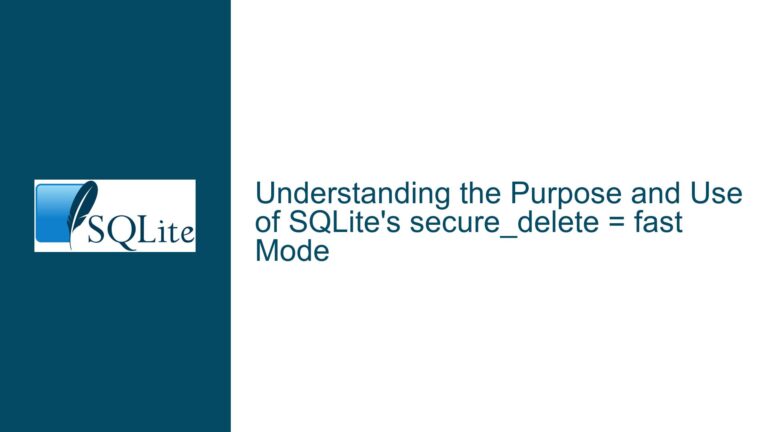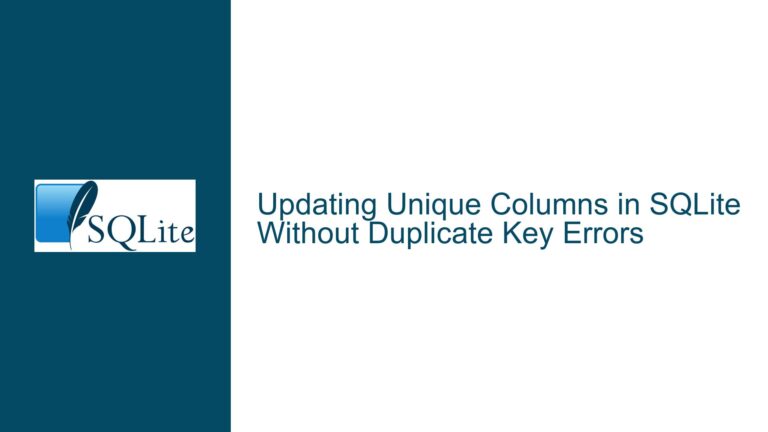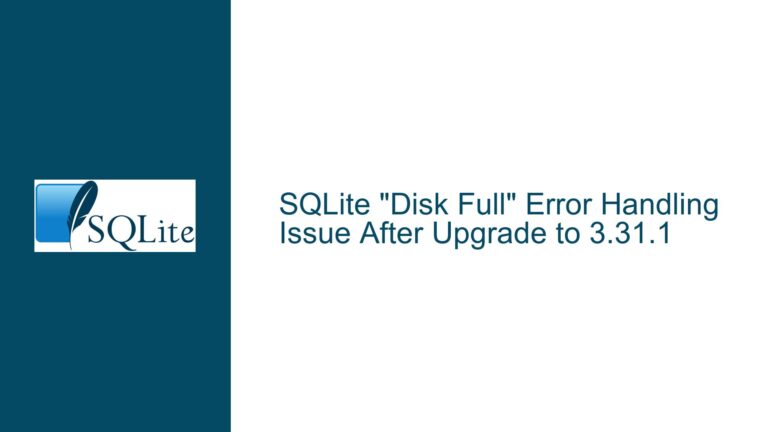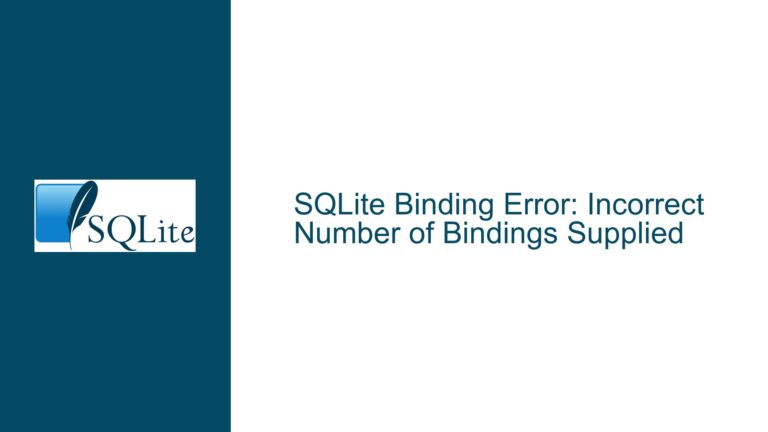Malformed SQLite Database Due to NTFS Volume Corruption on Linux
SQLite Database Corruption on NTFS Volumes Under Linux
The issue at hand involves a SQLite database becoming malformed during the process of loading a large table dump, specifically when the database resides on an NTFS volume under Linux. The user initially suspected memory constraints or SQLite configuration issues, but after extensive troubleshooting, the root cause was traced back to the NTFS filesystem implementation on Linux. The corruption occurs consistently when committing large transactions, leading to a malformed database image. This issue is exacerbated by the interaction between SQLite’s transaction handling and the NTFS filesystem’s behavior under stress.
The user attempted various workarounds, including increasing swap space, adjusting SQLite’s cache size, and modifying system memory settings to prevent the process from being killed by the system’s out-of-memory (OOM) killer. However, these measures only mitigated the symptoms temporarily. The ultimate resolution involved reformatting the volume to ext4, which eliminated the corruption issues entirely. This suggests that the problem lies not with SQLite itself but with the NTFS filesystem’s handling of large, high-stress transactions on Linux.
Interrupted Write Operations and Filesystem Limitations
The primary cause of the database corruption appears to be interrupted write operations on the NTFS volume under Linux. SQLite relies heavily on the underlying filesystem to ensure atomic commits and data integrity. When SQLite writes to a database, it uses a journaling mechanism to ensure that transactions are atomic and durable. However, if the filesystem fails to handle these writes correctly—especially under high load or with large transactions—the database can become corrupted.
In this case, the NTFS implementation on Linux appears to struggle with the demands placed on it by SQLite’s transaction model. Specifically, the filesystem may not handle large, sequential writes efficiently, leading to partial writes or corruption. This is particularly problematic when the database is subjected to high-stress operations, such as loading a large table dump. The user observed that the corruption consistently occurred around the 50% mark of the table dump, suggesting that the filesystem’s limitations were being exceeded at that point.
Additionally, the user encountered issues with the integrity of the SQL dump file itself. The file contained invalid UTF-8 sequences, which further complicated the recovery process. While this was not the root cause of the corruption, it highlights the importance of ensuring data integrity at every stage of the process, from exporting the database to importing it on a new system.
Recovering Data and Migrating to a Robust Filesystem
To resolve the issue, the user took several steps to recover the corrupted data and migrate to a more reliable filesystem. The first step was to identify and clean the corrupted SQL dump file. The user used the iconv utility to remove invalid UTF-8 sequences, which allowed the file to be processed without errors. This step was crucial for ensuring that the data could be imported into a new database without further issues.
Once the SQL dump file was cleaned, the user attempted to reconstruct the database on the NTFS volume. However, this approach proved unsuccessful, as the corruption reoccurred during subsequent transactions. This led the user to conclude that the NTFS volume itself was the root cause of the problem. To address this, the user reformatted the volume to ext4, a filesystem known for its robustness and performance under high-stress conditions.
After reformatting the volume, the user restored the database files and successfully loaded the table dump without encountering any further corruption. This solution highlights the importance of choosing the right filesystem for database workloads, particularly when dealing with large datasets and high transaction volumes.
Detailed Troubleshooting Steps
Identify and Clean Corrupted Data: Use tools like
iconvto remove invalid UTF-8 sequences from the SQL dump file. This ensures that the data can be imported without errors.iconv -f utf-8 -t utf-8 -c hash.sql.08 > hash.sql.08.bVerify Filesystem Integrity: Check the integrity of the NTFS volume using tools like
ntfsfixorchkdskon Windows. This helps identify any underlying filesystem issues that may contribute to the corruption.Reconstruct the Database: Attempt to reconstruct the database on the NTFS volume. If corruption reoccurs, this indicates that the filesystem is not suitable for the workload.
Migrate to a Robust Filesystem: Reformat the volume to a more reliable filesystem like ext4. This eliminates the filesystem-related issues and provides a stable environment for the database.
Restore and Test the Database: Restore the database files to the new volume and verify that the table dump can be loaded without errors. Perform thorough testing to ensure data integrity and stability.
Best Practices for Preventing Future Issues
Choose the Right Filesystem: For database workloads, use filesystems known for their robustness and performance, such as ext4 or XFS. Avoid using NTFS on Linux for high-stress database operations.
Monitor System Resources: Ensure that the system has sufficient memory and swap space to handle large transactions. Adjust SQLite’s cache size and other configuration parameters to optimize performance.
Regular Backups: Maintain regular backups of the database to facilitate recovery in case of corruption. Use tools like
sqlite3 .dumpto create SQL dump files that can be easily restored.Data Integrity Checks: Perform regular integrity checks on the database using
PRAGMA integrity_check. This helps identify and address potential issues before they lead to corruption.Test Under Load: Before deploying a database in a production environment, test it under conditions that simulate the expected workload. This helps identify any filesystem or configuration issues that may arise under stress.
By following these steps and best practices, you can prevent database corruption and ensure the stability and reliability of your SQLite databases, even under high-stress conditions.






